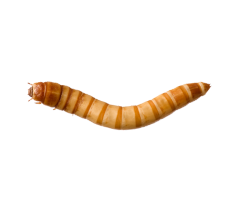| Common Name | Mealworm |
| Scientific Name | Tenebrio molitor |
| Size | 1/2" - 1" |
Mealworms (Tenebrio molitor) are the larvae of mealworm beetles. Like most holometabolic insects, they have four stages of life: egg, larva, pupa and adult. Mealworms have one purpose, to eat and grow until they have enough energy stored in their bodies to transform into a pupa and, eventually, a beetle!
Mealworms can be found almost all over the world in warm and dark places. Burrowing and eating are a top priority when it comes to being a mealworm, and they will eat just about anything. They will eat grains, vegetables, any organic material, fresh or decaying. This plays a huge role in the ecosystem. Mealworms aid in the decomposition of any spoiled organic material.
Mealworms are also an abundant food source for many animals. Birds, spiders, reptiles, even other insects prey on mealworms to find a high protein and fat source in the wild, and it is much the same in captivity! Mealworms are used as feeder insects for a lot of popular pets, such as bearded dragons, chickens, even fish. Check out our analysis of a typical Fluker mealworm:
Analysis of a Mealworm
Moisture 62.62%
Fat 10.01%
Protein 10.63%
Fiber 3.1%
Calcium 420 ppm
Caring for Mealworms:
A one thousand count bulk of mealworms can be kept in a large plastic container, with air holes in the top. You should cover the mealworms with a thick layer of wheat middling, oat meal, or Fluker's mealworm bedding to provide bedding and a food source.
Mealworms are relatively easy to keep and provide excellent nutrition for your pets.
Upon arrival, place them in a refrigerator set at 45°F until ready for use. When you are ready to use them, remove the desired amount and leave at room temperature until they become active, roughly 24 hours before feeding to your animal.
If you plan to keep the mealworms for longer than two weeks, remove them from the refrigerator and let them become active. Once they become active, place a slice of potato on the top of the bedding to provide moisture, and let them sit for 24 hours. Then, place them back in the refrigerator.


